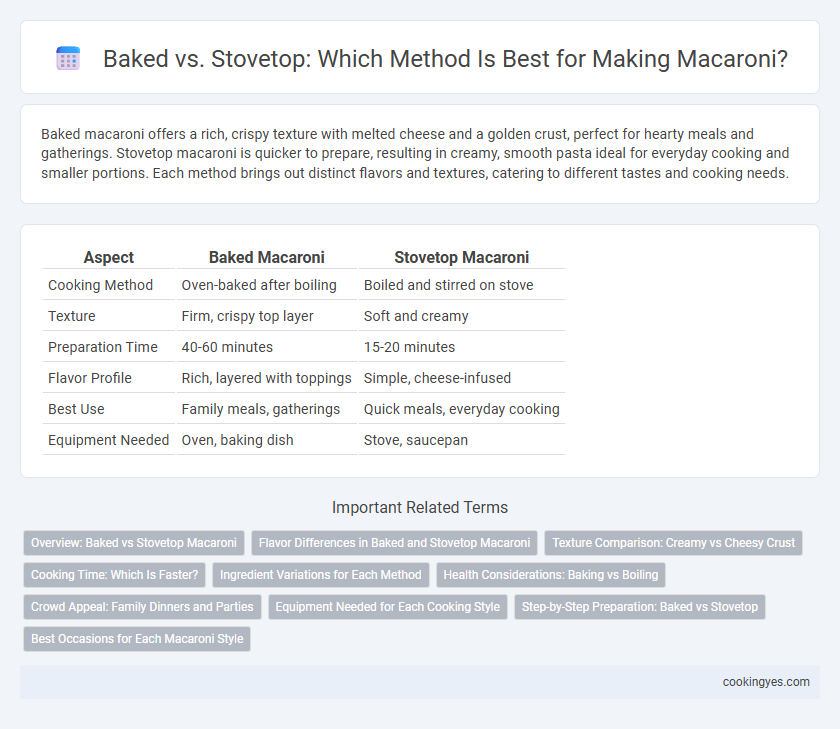Baked macaroni offers a rich, crispy texture with melted cheese and a golden crust, perfect for hearty meals and gatherings. Stovetop macaroni is quicker to prepare, resulting in creamy, smooth pasta ideal for everyday cooking and smaller portions. Each method brings out distinct flavors and textures, catering to different tastes and cooking needs.
Table of Comparison
| Aspect | Baked Macaroni | Stovetop Macaroni |
|---|---|---|
| Cooking Method | Oven-baked after boiling | Boiled and stirred on stove |
| Texture | Firm, crispy top layer | Soft and creamy |
| Preparation Time | 40-60 minutes | 15-20 minutes |
| Flavor Profile | Rich, layered with toppings | Simple, cheese-infused |
| Best Use | Family meals, gatherings | Quick meals, everyday cooking |
| Equipment Needed | Oven, baking dish | Stove, saucepan |
Overview: Baked vs Stovetop Macaroni
Baked macaroni offers a hearty texture with a golden, crispy top layer achieved through oven cooking, enhancing flavor complexity and offering a gratin-style finish. Stovetop macaroni provides quicker preparation time with a creamy, smooth consistency by combining pasta and sauce in a single pot, maintaining moisture and rich taste. Choosing between baked and stovetop methods depends on desired texture, cooking time, and convenience preferences.
Flavor Differences in Baked and Stovetop Macaroni
Baked macaroni develops a richer, caramelized flavor due to the Maillard reaction during oven cooking, enhancing the dish's depth with browned cheese and crispy edges. Stovetop macaroni retains a creamier, smoother texture with a more pronounced cheese sauce flavor, as it cooks faster without the dry heat effect. The choice between baked and stovetop preparation significantly influences the balance of textures and intensity of cheesy, savory notes in the final dish.
Texture Comparison: Creamy vs Cheesy Crust
Baked macaroni offers a distinctive texture characterized by a golden, crispy cheese crust that contrasts with a tender, baked interior. Stovetop macaroni maintains a consistently creamy texture throughout, allowing the cheese sauce to remain smooth and luscious without forming a crust. Texture preferences hinge on whether one values the crunchy, browned topping of baked dishes or the velvety, uniform creaminess of stovetop preparations.
Cooking Time: Which Is Faster?
Stovetop macaroni typically cooks faster, taking about 10-15 minutes, as the pasta simmers directly in boiling water or sauce, allowing immediate heat transfer. Baked macaroni requires additional time, generally 30-45 minutes, because it involves baking the assembled dish in the oven, allowing flavors to meld and cheese to brown. For quick meals, stovetop preparation saves significant time compared to the slower, more involved baking process.
Ingredient Variations for Each Method
Baked macaroni recipes often incorporate ingredients like shredded cheese, breadcrumbs, and creamy sauces that bake into a golden crust, enhancing texture and flavor depth. Stovetop macaroni typically features simpler ingredient combinations such as cheddar cheese, milk, and butter, creating a smooth, creamy consistency without the crunchy topping. Ingredient variations for baked versus stovetop methods influence both the dish's richness and preparation time, catering to different taste preferences and meal occasions.
Health Considerations: Baking vs Boiling
Baking macaroni often involves added fats and cheeses, increasing calorie and saturated fat content compared to boiling on the stovetop. Boiling macaroni allows for better control over portion sizes and reduces the need for heavy additives, making it a lighter option for those monitoring fat intake or calories. Health-conscious individuals may prefer stovetop preparation to minimize excess oils and maintain more natural nutrient content in their macaroni dishes.
Crowd Appeal: Family Dinners and Parties
Baked macaroni offers a crispy, golden topping and rich, melded flavors that make it a favorite for family dinners and parties, attracting crowds with its comforting texture and visually appealing presentation. Stovetop macaroni provides a quicker, creamier option that's easier to customize and serve in large quantities, making it ideal for casual gatherings and quick meal prep. Both methods cater to crowd appeal, with baked macaroni excelling in traditional, sit-down meals and stovetop macaroni suiting informal, fast-paced events.
Equipment Needed for Each Cooking Style
Baked macaroni requires oven-safe cookware, such as a baking dish or casserole, to ensure even heat distribution and browning, along with a stovetop pot for boiling the pasta initially. Stovetop macaroni preparation relies mainly on a large pot for boiling pasta and a skillet or saucepan for mixing and cooking ingredients together directly on the stove. While baked macaroni often calls for additional tools like a mixer or cheese graters, stovetop methods focus on minimal equipment, emphasizing speed and simplicity.
Step-by-Step Preparation: Baked vs Stovetop
Baked macaroni preparation begins with boiling pasta until al dente, mixing it with cheese sauce and other ingredients, then transferring the mixture to a baking dish topped with breadcrumbs before baking at 350degF for 20-30 minutes to achieve a golden crust. Stovetop macaroni involves boiling the pasta and immediately stirring in a cheese sauce made from butter, flour, milk, and cheese, cooked together over medium heat until thickened, resulting in a creamy texture without baking. The baked method offers a crispy, layered dish, while stovetop macaroni delivers faster, creamier results with fewer steps and less cleanup.
Best Occasions for Each Macaroni Style
Baked macaroni excels for family gatherings or holiday meals, where its crispy, golden top and rich, creamy filling provide comfort and a visually appealing centerpiece. Stovetop macaroni suits quick weeknight dinners or casual lunches, offering speedy preparation and a smooth, cheesy texture ideal for individual servings or smaller groups. Choosing baked or stovetop macaroni depends on the occasion's formality and time availability, balancing convenience with presentation.
Baked vs Stovetop for Macaroni Preparation Infographic

 cookingyes.com
cookingyes.com